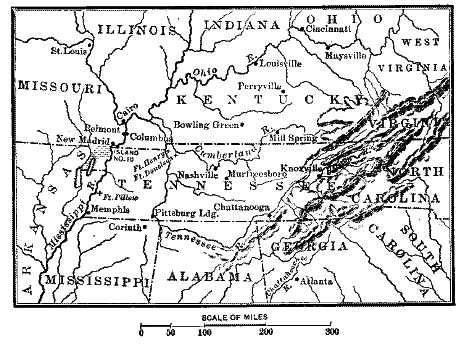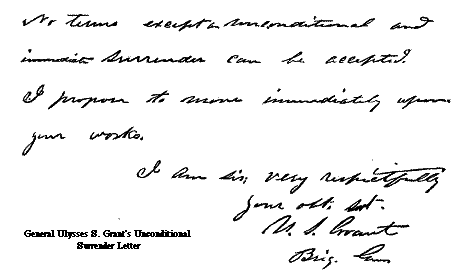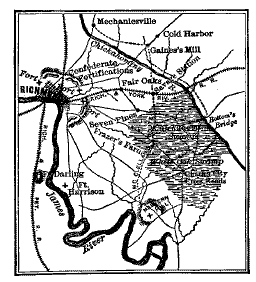Resource Center OLLibrary
|
292 |
|
[1862 |
331. The War in the West; Capture of Fort
Henry and Fort Donelson. At the West the line of the
Confederate army, under General A. S. Johnston, stretched from
Mill Spring and Bowling Green, in Kentucky, through Fort Donelson
on the Cumberland and Fort Henry on the Tennessee, to Columbus on
the Mississippi. (Map, below.) General Halleck,1 in
command of the greater part of the Union forces of the West,
resolved to break that line, to enter the cotton states, and also
to open the Mississippi. In

January (1862), General Thomas gained a victory at Mill Spring
and drove the Confederates out of eastern Kentucky. Then General
Halleck ordered General U. S. Grant 2 to start from
Cairo, Illinois,
1 General Halleck was
born near Utica, New York, 1815; died, 1872. He graduated at West
Point and served in the Mexican War. He was appointed a major
general of the United States army in August, 1861. He received
command of the department of Missouri (with other states) in
November, and of the department of the Mississippi in March, 1862.
From July 11, 1862, to March, 1864, he was general in chief of the
armies of the United States, and had his headquarters at
Washington.
2 General U. S. Grant was born in
Ohio, 1822; died in New York, 1885. He was a graduate of West
Point, and served in the Mexican War (§ 293), where he was
promoted for meritorious conduct in battle. In 1859 he entered the
leather and saddlery business with his father at Galena, Illinois.
On the breaking out of the Civil War he raised a company of Union
volunteers, and in August, 1861, he was made a brigadier general,
and took command of the department of Cairo. His subsequent career
will be traced in the pages of this history.

|
294 |
|
[1861 |
and attack Fort Henry; but Commodore Foote got there first with
his gunboats and took it (February 6, 1862). Grant then moved on
Fort Donelson. The battle raged for three days in succession; then
the Confederate General Buckner asked Grant what terms he would
grant him if he gave up the fort. Grant wrote back, "No terms
except an unconditional and immediate surrender can be
accepted."1 The Confederates were forced to agree
to Grant's conditions, and the first great Union victory of the
war was won (February 16, 1862). Grant captured 15,000 prisoners
-- "the greatest number ever taken in any battle (up to that time)
on this continent" -- and also large quantities of arms. Columbus
was now of no use to the Confederates and they abandoned it. The
surrender of Nashville followed, and Kentucky and Tennessee were
in the hands of the Union forces.
332. Battles of Pittsburg Landing and Island
Number Ten. Grant, with his victorious army, then moved up the
Tennessee River to Pittsburg Landing, or Shiloh. Here (April 6,
1862) he was attacked by General A. S. Johnston and driven back.
The night after the battle General Buell brought a large force of
Union troops. (Map, p. 292.) The Union men now outnumbered the
Confederates by 17,000, and the next day Grant gained his second
great victory. In his official report he said, "I am indebted to
General Sherman for the success of that battle." On that hotly
contested field 25,000 men had fallen dead or wounded;
2 among them was General A. S. Johnston, one of the
South's noblest men.3 On the following day. (April 8,
1862) the Confederates on Island Number Ten, in the Mississippi
(Map, p. 292), surrendered to Commodore Foote, after nearly a
month's obstinate fighting. That victory was of immense
importance, for it opened the river to the Union vessels down to
Vicksburg, a distance of about three hundred miles.
333. General Summary of the First Year of the
War (April, 1861-April, 1862). The Civil War began (April 12,
1861) with the
1 Hence the name
sometimes given General Grant of "Unconditional Surrender Grant."
See copy of General Grant's letter to General Buckner on page
293.
2 Union force, 57,000; Confederate,
40,000, Union loss, 14,000; Confederate, 11,000.
3 After he was wounded, General
Johnston sent his surgeon to attend to some wounded Union
prisoners; while he was gone Johnston bled to death.
|
1862] |
|
295 |
Confederate attack on Fort Sumter. After the surrender of that
fort, the first great battle was fought in the summer at Bull Run,
and resulted in the defeat of the Union army. The next spring
(1862) the battle between the Merrimac and Monitor
occurred, and the Merrimac was forced to retreat. During
the year the Union forces in the West gained the important
victories of Fort Henry, Fort Donelson, Pittsburg Landing, and
Island Number Ten. The general result of the year's war was
decidedly favorable to the cause of the Union, especially in the
West.
334, Expedition against New Orleans; how
the City was defended. Very early in the spring (1862) an
expedition under Captain Farragut1 and General Butler
sailed from Fort Monroe to attack New Orleans, the most important
city and port in the possession of the Confederate government. The
approach to New Orleans was defended by two strong forts on the
Mississippi, about seventy-five miles below the city.2
These forts were nearly opposite each other, so that any vessels
trying to pass between them would be exposed to a tremendous cross
fire from their guns. just below the forts the Confederates had
stretched two heavy chain cables, on hulks, across the river to
check any Union war ships that might attempt to come up, while
above the forts they had stationed fifteen armed vessels -- two of
them ironclads like the Merrimac (§ 330). With these
defenses the city defied attack.
Captain Farragut had a fleet of nearly fifty
wooden vessels. It was considered to be the most powerful "that
had ever sailed under
1 Admiral David G.
Farragut, born in Tennessee in 1801; died, 1870. He entered the
navy in 1812. In 1841 he was made commander, and later captain. In
1862, after his famous victory at New Orleans, he was promoted to
the rank of rear admiral, then (1864) to that of vice admiral, and
in 1866 to that of admiral, the highest position in the United
States navy; the last two grades were created for him. From 1823
to the outbreak of the Civil War, Farragut's home, when on shore,
was at Norfolk, Virginia. He insisted that Virginia had been
forced to secede against the will of the majority of the people of
the state. From 1861 to the close of his life his home was at
Hastings-on-the-Hudson.
2 New Orleans is about one hundred
and five miles from the sea. In the War of 1812 a single fort, at
one of the points where those two Confederate forts stood, checked
the advance of the British fleet for nine days.
|
296 |
|
[1862 |
the American flag." General Butler followed him to take command
of a force of 15,000 men, to hold the city after its surrender.
Farragut's work, with the aid of Commander Porter's mortar
boats,1 was to silence the forts, break through the
chains, conquer the Confederate fleet, and take the city. One of
the men who took part in that work was Lieutenant George Dewey,
now Admiral Dewey, -- the "Hero of Manila" (§ 415).
335. Bombardment of the Forts; Farragut
passes them and destroys the Opposing Fleet; Capture of New
Orleans. For six days and nights Commander Porter hammered
away at the forts, and the forts hammered back. The discharge of
artillery was deafening, and the shock so severe that it killed
birds and fishes. It even broke glass in windows at Balize, thirty
miles away.2 Porter's men were completely exhausted by
their labors at the guns, and the moment they were off duty they
would drop down on the deck and fall fast asleep, amid the
continuous roar of the battle.
Finally, Captain Farragut determined to make an
attempt to cut through the chains and run past the forts. He
succeeded in doing this, and, after a terrific combat, destroyed
the Confederate fleet and reached New Orleans.
The river front of the city, for a distance of
five miles, was all ablaze with burning ships, steamboats, and
bales of cotton. The Confederates had set them on fire to prevent
the Union forces from seizing them. A party of Farragut's men
landed, speedily hauled down the Stars and Bars from the public
buildings, and hoisted the Stars and Stripes in their place (April
25, 1862). Not long after this, Farragut was honored with the
title of Rear Admiral.
Port Hudson and Vicksburg were now the only
important fortified points on the Mississippi still held by the
Confederates. If the Union forces could take them, the great river
of the West
1 Mortar boats:
vessels for carrying mortars, -- short and very wide-mouthed
cannon for firing shells. The shells used here were hollow
cast-iron balls of great size, weighing nearly three hundred
pounds. They were filled with powder, and so constructed that when
they fell they would explode with tremendous violence. The shells
made a peculiar screaming, hissing noise as they flew through the
air, accompanied by a train of smoke by day and of fire by night.
When one buried itself in the earth inside of one of the forts and
then exploded, the result was like that of a small earthquake.
2 See Draper's "The American Civil
War," II, 331
|
1862] |
|
297 |
|
would once more be open from its source to the sea.
But both Port Hudson and Vicksburg stood on immensely
high bluffs, out of the reach of the guns of the war
vessels, so that it would be exceedingly difficult to
capture them by an attack from the river. For this reason
it was decided to let them alone until a land force could
be sent to join in the attack. |
 Meanwhile,
the Union navy had captured several important points on
the coast of North and South Carolina.
Meanwhile,
the Union navy had captured several important points on
the coast of North and South Carolina.


